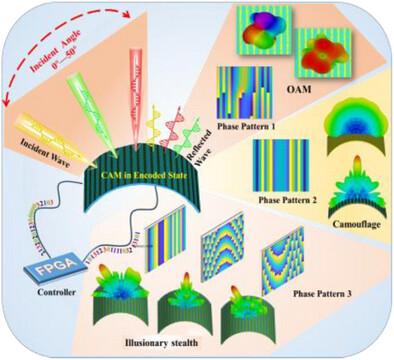用于动态光束控制和轨道角动量产生的广角共形主动超表面
IF 10
1区 物理与天体物理
Q1 OPTICS
引用次数: 0
摘要
由于其前所未有的操纵电磁波的能力,元表面引起了长期的研究兴趣,并开发了许多引人注目的应用,而新兴的可编程编码元表面提供了一个实时可重构的平台来动态实现定制功能。然而,被动超表面一旦制造出来,就缺乏动态可调性,而现有的基于超表面的隐身设计主要基于平面超表面,这严重限制了它们在曲面平台上的适用性。在这项工作中,提出了一种创新的共形主动超表面(CAM)策略,通过将3D打印的曲面基片与电压可编程的2位相位编码相结合。该设计实现了双功能可调谐电磁波功能,用于雷达截面(RCS)增强的自适应波束转向,以及用于9.3至10.5 GHz通信的轨道角动量(OAM)涡旋波产生。仿真和实验结果表明,在光束导向模式下,该凸轮能使入射波在0°~ 50°范围内发生偏转,并能达到预设的反射方向,指向精度优于±2°。RCS在入射方向上降低了10 dB以上,而在预设反射方向上增强了8.9 dB,有效地实现了广角雷达的幻觉隐身和伪装隐身。在OAM模式下,CAM在150mm处产生涡旋波束,可以有效提高无线通信系统的频谱效率。这种有前途的设计为智能元表面的发展铺平了道路,具有增强的可维护性和灵活性,为通信、隐身和其他多功能智能元设备的应用提供了巨大的潜力。本文章由计算机程序翻译,如有差异,请以英文原文为准。

Wide‐Angle Conformal Active Metasurface for Dynamic Beam Steering and Orbital Angular Momentum Generation
Metasurfaces have intrigued long‐standing research interests and developed multitudinous compelling applications owing to their unprecedented capability for manipulating electromagnetic (EM) waves, and the emerging programmable coding metasurfaces provide a real‐time reconfigurable platform to dynamically implement customized functions. Nevertheless, the passive metasurfaces, once fabricated, lack dynamic tunability, while existing metasurface‐based stealth designs are primarily based on planar metasurfaces, which severely limit their applicability to curved platforms. In this work, an innovative strategy is proposed for conformal active metasurface (CAM) by integrating 3D‐printed curved substrates with voltage‐programmable 2‐bit phase coding. This design enables dual‐functional tunable EM waves functions in adaptive beam steering for radar cross‐section (RCS) enhancement and in vortex wave generation with orbital angular momentum (OAM) for communication from 9.3 to 10.5 GHz. Simulation and experimental results demonstrate that the CAM can deflect incident waves with angles ranging from 0° to 50° in the beam‐steering mode and achieve preset reflection directions with a pointing accuracy of better than ±2°. The RCS is reduced by more than 10 dB along the incident direction, while it is enhanced by up to +8.9 dB in the preset reflection direction, effectively enabling wide‐angle radar stealth for both illusionary stealth and camouflage. In the OAM mode, the CAM generates vortex beams with OAM at 150 mm, which can effectively increase the spectral efficiency of wireless communication systems. This promising design paves the way for the development of intelligent metasurfaces with enhanced serviceability and flexibility, offering tremendous potential for applications in communication, stealth, and other multifunctional smart metadevices.
求助全文
通过发布文献求助,成功后即可免费获取论文全文。
去求助
来源期刊
CiteScore
14.20
自引率
5.50%
发文量
314
审稿时长
2 months
期刊介绍:
Laser & Photonics Reviews is a reputable journal that publishes high-quality Reviews, original Research Articles, and Perspectives in the field of photonics and optics. It covers both theoretical and experimental aspects, including recent groundbreaking research, specific advancements, and innovative applications.
As evidence of its impact and recognition, Laser & Photonics Reviews boasts a remarkable 2022 Impact Factor of 11.0, according to the Journal Citation Reports from Clarivate Analytics (2023). Moreover, it holds impressive rankings in the InCites Journal Citation Reports: in 2021, it was ranked 6th out of 101 in the field of Optics, 15th out of 161 in Applied Physics, and 12th out of 69 in Condensed Matter Physics.
The journal uses the ISSN numbers 1863-8880 for print and 1863-8899 for online publications.

 求助内容:
求助内容: 应助结果提醒方式:
应助结果提醒方式:


